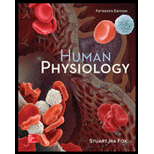
Human Physiology
15th Edition
ISBN: 9781259864629
Author: Fox, Stuart Ira
Publisher: Mcgraw-hill Education,
expand_more
expand_more
format_list_bulleted
Question
Chapter 19, Problem 22RA
Summary Introduction
To review:
The comparison and contrast of the
Introduction:
The endocrine system regulates the physiological process by secreting different forms of hormones that play major roles in the metabolic regulations. The master gland of the endocrine system is the pituitary gland, whichcontrols all the other glands by releasing stimulating hormones. Thyroid-stimulating hormone is an example of stimulating hormones.
Expert Solution & Answer
Want to see the full answer?
Check out a sample textbook solution
Students have asked these similar questions
Please draw in the missing answer, thank you
Please fill in all blank questions, Thank you
please fill in missing parts , thank you
Chapter 19 Solutions
Human Physiology
Ch. 19 - Explain how the metabolic rate is influenced by...Ch. 19 - Prob. 2aCPCh. 19 - Prob. 2bCPCh. 19 - Prob. 3CPCh. 19 - Distinguish between the energy reserves and...Ch. 19 - Prob. 5CPCh. 19 - Identify the brain regions involved in hunger and...Ch. 19 - Prob. 7CPCh. 19 - Describe how the secretions of insulin and...Ch. 19 - Prob. 8bCP
Ch. 19 - Define the following terms: glycogenolysis,...Ch. 19 - Prob. 9CPCh. 19 - Prob. 10aCPCh. 19 - Prob. 10bCPCh. 19 - Explain the meaning of the terms insulin...Ch. 19 - Prob. 12aCPCh. 19 - Prob. 12bCPCh. 19 - Prob. 13aCPCh. 19 - Prob. 13bCPCh. 19 - Describe the mechanisms by which the secretion of...Ch. 19 - Prob. 15aCPCh. 19 - Prob. 15bCPCh. 19 - Prob. 15cCPCh. 19 - ln questions 1-5, match the item to the correct...Ch. 19 - Prob. 2RACh. 19 - Prob. 3RACh. 19 - Prob. 4RACh. 19 - Prob. 5RACh. 19 - Prob. 6RACh. 19 - Prob. 7RACh. 19 - Prob. 8RACh. 19 - Prob. 9RACh. 19 - The increased intestinal absorption of calcium is...Ch. 19 - Prob. 11RACh. 19 - Prob. 12RACh. 19 - Prob. 13RACh. 19 - Prob. 14RACh. 19 - Prob. 15RACh. 19 - Prob. 16RACh. 19 - Prob. 17RACh. 19 - Prob. 18RACh. 19 - Prob. 19RACh. 19 - Prob. 20RACh. 19 - Prob. 21RACh. 19 - Prob. 22RACh. 19 - Prob. 23RACh. 19 - Prob. 24RACh. 19 - Prob. 25RACh. 19 - Prob. 26RACh. 19 - Prob. 27RACh. 19 - Describe the conditions of gigantism, acromegaly,...Ch. 19 - Describe how hormones secreted by the...Ch. 19 - Prob. 30RACh. 19 - Prob. 31RACh. 19 - Prob. 32RACh. 19 - Prob. 33RACh. 19 - Prob. 34RACh. 19 - Prob. 35RACh. 19 - Prob. 36RACh. 19 - Prob. 37RACh. 19 - Prob. 38RACh. 19 - Prob. 39RACh. 19 - Prob. 40RACh. 19 - Prob. 41RACh. 19 - Prob. 42RACh. 19 - Prob. 43RA
Knowledge Booster
Learn more about
Need a deep-dive on the concept behind this application? Look no further. Learn more about this topic, biology and related others by exploring similar questions and additional content below.Similar questions
- please draw in the answers, thank youarrow_forwarda. On this first grid, assume that the DNA and RNA templates are read left to right. DNA DNA mRNA codon tRNA anticodon polypeptide _strand strand C с A T G A U G C A TRP b. Now do this AGAIN assuming that the DNA and RNA templates are read right to left. DNA DNA strand strand C mRNA codon tRNA anticodon polypeptide 0 A T G A U G с A TRParrow_forwardplease answer all question below with the following answer choice, thank you!arrow_forward
- please draw in the answeres, thank youarrow_forwardA) What is being shown here?B) What is indicated by the RED arrow?C) What is indicated by the BLUE arrow?arrow_forwardPlease identify the curve shown below. What does this curve represent? Please identify A, B, C, D, and E (the orange oval). What is occurring in these regions?arrow_forward
- Please identify the test shown here. 1) What is the test? 2) What does the test indicate? How is it performed? What is CX? 3) Why might the test be performed in a clinical setting? GEN CZ CX CPZ PTZ CACarrow_forwardDetermine how much ATP would a cell produce when using fermentation of a 50 mM glucose solution?arrow_forwardDetermine how much ATP would a cell produce when using aerobic respiration of a 7 mM glucose solution?arrow_forward
- Determine how much ATP would a cell produce when using aerobic respiration to degrade one small protein molecule into 12 molecules of malic acid, how many ATP would that cell make? Malic acid is an intermediate in the Krebs cycle. Assume there is no other carbon source and no acetyl-CoA.arrow_forwardIdentify each of the major endocrine glandsarrow_forwardCome up with a few questions and answers for umbrella species, keystone species, redunant species, and aquatic keystone speciesarrow_forward
arrow_back_ios
SEE MORE QUESTIONS
arrow_forward_ios
Recommended textbooks for you
- Essentials of Pharmacology for Health ProfessionsNursingISBN:9781305441620Author:WOODROWPublisher:Cengage
 Human Physiology: From Cells to Systems (MindTap ...BiologyISBN:9781285866932Author:Lauralee SherwoodPublisher:Cengage Learning
Human Physiology: From Cells to Systems (MindTap ...BiologyISBN:9781285866932Author:Lauralee SherwoodPublisher:Cengage Learning  Human Biology (MindTap Course List)BiologyISBN:9781305112100Author:Cecie Starr, Beverly McMillanPublisher:Cengage Learning
Human Biology (MindTap Course List)BiologyISBN:9781305112100Author:Cecie Starr, Beverly McMillanPublisher:Cengage Learning

Essentials of Pharmacology for Health Professions
Nursing
ISBN:9781305441620
Author:WOODROW
Publisher:Cengage

Human Physiology: From Cells to Systems (MindTap ...
Biology
ISBN:9781285866932
Author:Lauralee Sherwood
Publisher:Cengage Learning


Human Biology (MindTap Course List)
Biology
ISBN:9781305112100
Author:Cecie Starr, Beverly McMillan
Publisher:Cengage Learning


What is Metabolism?; Author: Stated Clearly;https://www.youtube.com/watch?v=nRq6N5NGD1U;License: Standard youtube license